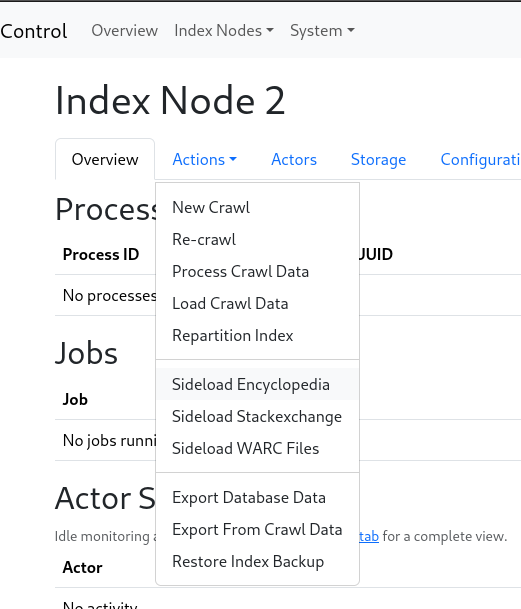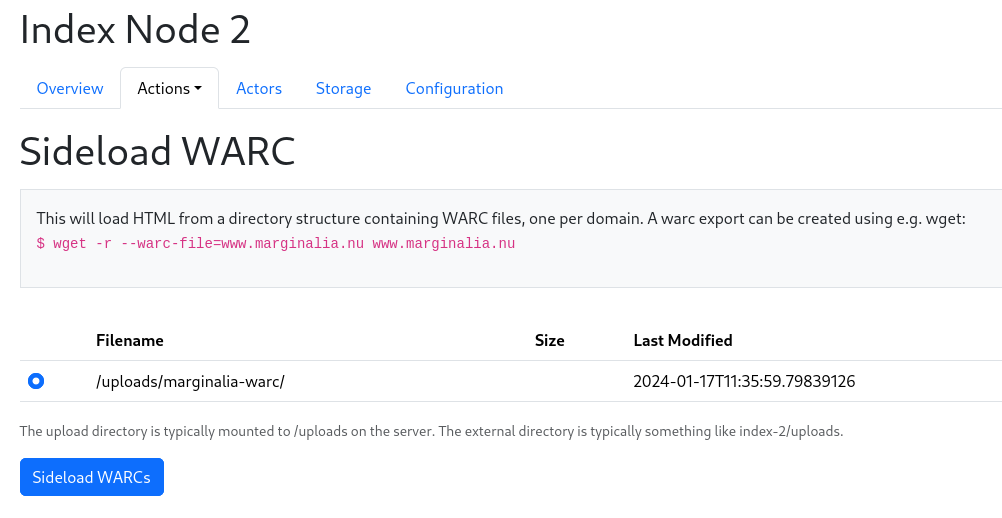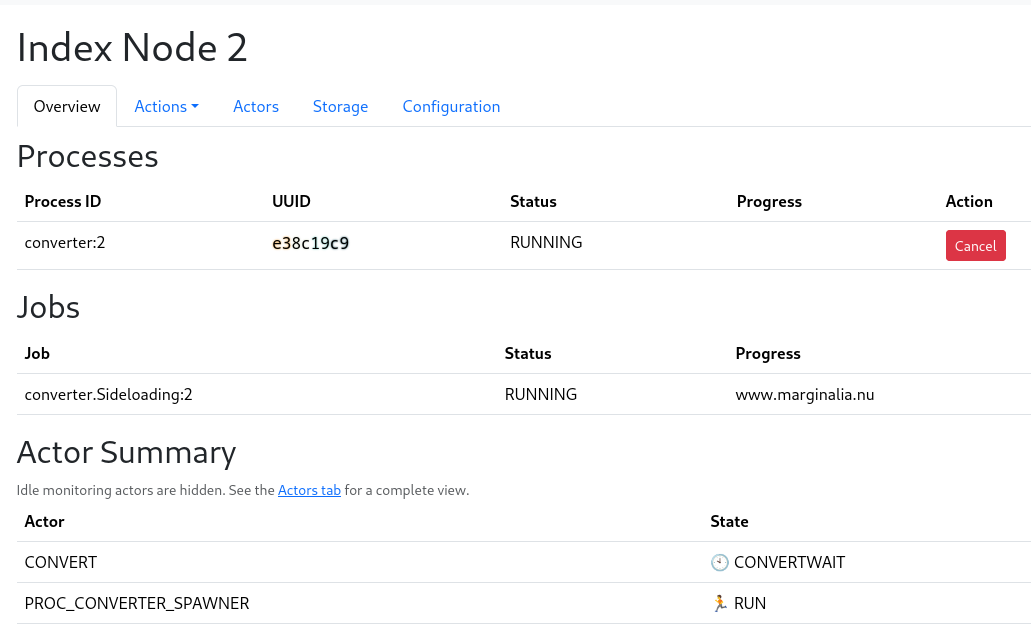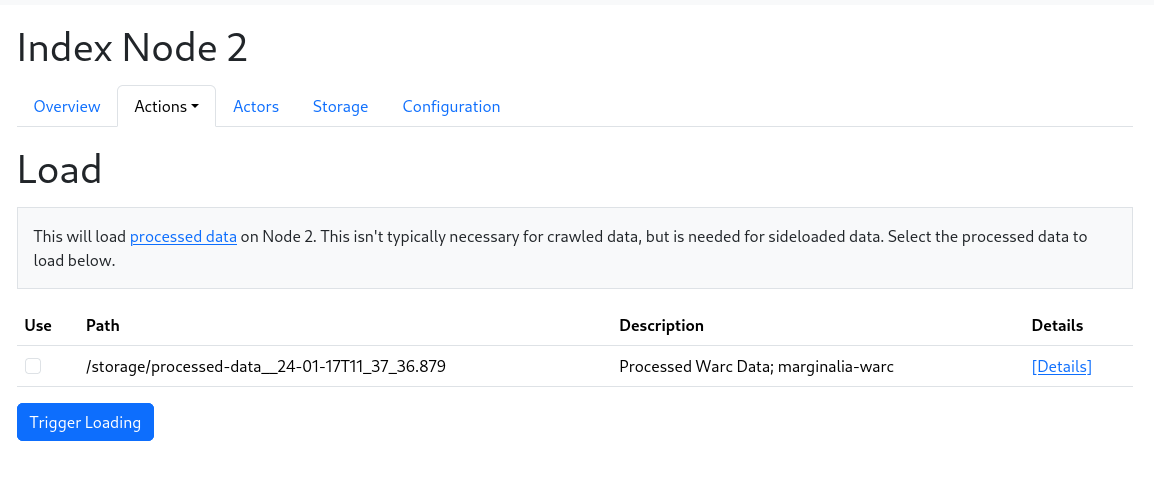Removed the need to have to run an external tool to pre-process the data in order to load stackexchange-style data into the search engine. Removed the tool itself. This stirred up some issues with the dependencies, that were due to both third-party:ing xz and importing it as a dependency. This has been fixed, and :third-party:xz was removed.
6.6 KiB
Sideloading How-To
Some websites are much larger than others, this includes Wikipedia, Stack Overflow, and a few others. They are so large they are impractical to crawl in the traditional fashion, but luckily they make available data dumps that can be processed and loaded into the search engine through other means.
To this end, it's possible to sideload data into the search engine from other sources than the web crawler.
Index Nodes
In practice, if you want to sideload data, you need to do it on a separate index node. Index nodes are separate instances of the index software. The default configuration is to have two index nodes, one for the web crawler, and one for sideloaded data.
The need for a separate node is due to incompatibilities in the work flows.
It is also a good idea in general, as very large domains can easily be so large that the entire time budget for the query is spent sifting through documents from that one domain, this is especially true with something like Wikipedia, which has a lot of documents at least tangentially related to any given topic.
This how-to assumes that you are operating on index-node 2.
Notes on the upload directory
This is written assuming that the system is installed with the install.sh
script, which deploys the system with docker-compose, and has a directory
structure like
...
index-1/backup/
index-1/index/
index-1/storage/
index-1/uploads/
index-1/work/
index-2/backup/
index-2/index/
index-2/storage/
index-2/uploads/
index-2/work/
...
We're going to be putting files in the uploads directories. If you have installed the system in some other way, or changed the configuration significantly, you need to adjust the paths accordingly.
Sideloading
The sideloading actions are available through Actions menu in each node.
Sideloading WARCs
WARC files are the standard format for web archives. They can be created e.g. with wget. The Marginalia software can read WARC files directly, and sideload them into the index, as long as each warc file contains only one domain.
Let's for example archive www.marginalia.nu (I own this domain, so feel free to try this at home)
$ wget -r --warc-file=marginalia www.marginalia.nu
Note If you intend to do this on other websites, you should probably add a --wait parameter to wget,
e.g. wget --wait=1 -r --warc-file=... to avoid hammering the website with requests and getting blocked.
This will take a moment, and create a file called marginalia.warc.gz. We move it to the
upload directory of the index node, and sideload it through the Actions menu.
$ mkdir -p index-2/uploads/marginalia-warc
$ mv marginalia.warc.gz index-2/uploads/marginalia-warc
Go to the Actions menu, and select the "Sideload WARC" action. This will show a list of subdirectories in the Uploads directory. Select the directory containing the WARC file, and click "Sideload".
This should take you to the node overview, where you can see the progress of the sideloading. It will take a moment, as the WARC file is being processed.
It will not be loaded automatically. This is to permit you to sideload multiple sources.
When you are ready to load it, go to the Actions menu, and select "Load Crawl Data".
Select all the sources you want to load, and click "Load". This will load the data into the index, and make it available for searching.
Sideloading Wikipedia
Due to licensing incompatibilities with OpenZim's GPL-2 and AGPL, the workflow depends on using the conversion process from https://encyclopedia.marginalia.nu/ to pre-digest the data.
Build the encyclopedia.marginalia.nu Code and follow the instructions for downloading a ZIM file, and then run something like
$./encyclopedia convert file.zim articles.db
This db-file can be processed and loaded into the search engine through the Actions view.
FIXME: It will currently only point to en.wikipedia.org, this should be made configurable.
Sideloading a directory tree
For relatively small websites, ad-hoc side-loading is available directly from a folder structure on the hard drive. This is intended for loading manuals, documentation and similar data sets that are large and slowly changing.
A website can be archived with wget, like this
UA="search.marginalia.nu" \
DOMAIN="www.example.com" \
wget -nc -x --continue -w 1 -r -U ${UA} -A "html" ${DOMAIN}
After doing this to a bunch of websites, create a YAML file something like this:
sources:
- name: jdk-20
dir: "jdk-20/"
domainName: "docs.oracle.com"
baseUrl: "https://docs.oracle.com/en/java/javase/20/docs"
keywords:
- "java"
- "docs"
- "documentation"
- "javadoc"
- name: python3
dir: "python-3.11.5/"
domainName: "docs.python.org"
baseUrl: "https://docs.python.org/3/"
keywords:
- "python"
- "docs"
- "documentation"
- name: mariadb.com
dir: "mariadb.com/"
domainName: "mariadb.com"
baseUrl: "https://mariadb.com/"
keywords:
- "sql"
- "docs"
- "mariadb"
- "mysql"
| parameter | description |
|---|---|
| name | Purely informative |
| dir | Path of website contents relative to the location of the yaml file |
| domainName | The domain name of the website |
| baseUrl | This URL will be prefixed to the contents of dir |
| keywords | These supplemental keywords will be injected in each document |
The directory structure corresponding to the above might look like
docs-index.yaml
jdk-20/
jdk-20/resources/
jdk-20/api/
jdk-20/api/[...]
jdk-20/specs/
jdk-20/specs/[...]
jdk-20/index.html
mariadb.com
mariadb.com/kb/
mariadb.com/kb/[...]
python-3.11.5
python-3.11.5/genindex-B.html
python-3.11.5/library/
python-3.11.5/distutils/
python-3.11.5/[...]
[...]
This yaml-file can be processed and loaded into the search engine through the Actions view.
Sideloading Stack Overflow/Stackexchange
Stackexchange makes dumps available on Archive.org. These are unfortunately on a format that needs some heavy-handed pre-processing before they can be loaded. A tool is available for this in tools/stackexchange-converter.
After running gradlew dist, this tool is found in build/dist/stackexchange-converter,
follow the instructions in the stackexchange-converter readme, and
convert the stackexchange xml.7z-files to sqlite db-files.
A directory with such db-files can be processed and loaded into the search engine through the Actions view.



